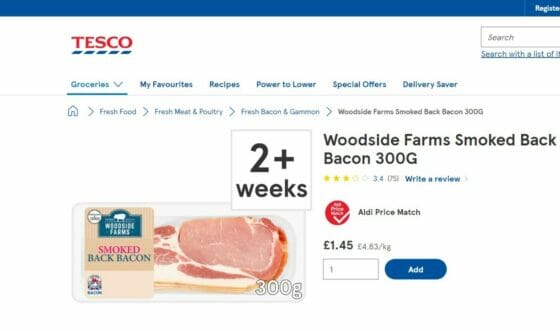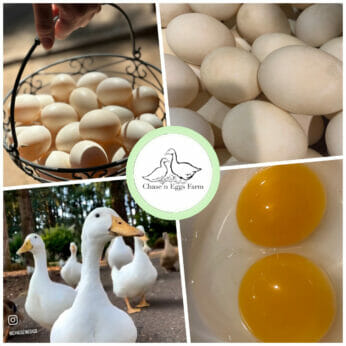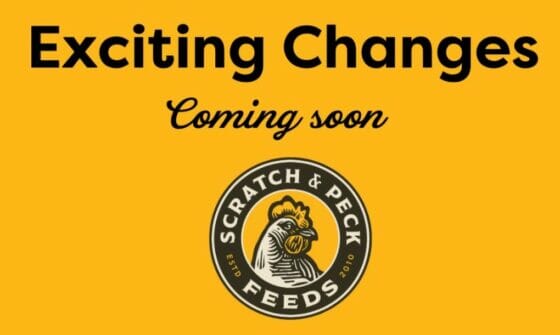Food labels are loaded with words and images that convey meaning. Knowing the story of your food means sifting through the true, the false and everything in between.

SweetRoot Farm is pitched squarely in the middle of a long and narrow mountain valley, framed by the Bitterroot Mountains on one side and the Sapphire Mountains on the other. The 10-acre farm outside Hamilton, Montana is run by Noah Jackson and Mary Bricker, who dedicate four irrigated acres of pasture to their laying hens.
Customers who buy their eggs at the farmer’s market in downtown Hamilton or who swing through their farm store can pick up a carton with a very simple design. It displays the SweetRoot Farm logo—a beet sticking out of a row of dirt—and the text “Pastured eggs. Organic, GMO-free feed and whole grains, moved to fresh pasture regularly. Available for farm pickup at the farmhouse. Noah & Mary.” The label then tells you where to find them by listing their address and phone number.
The label describes their feed, which Jackson has recently started buying from a ranch a few miles north. It emphasizes the use of pasture, sections of which the hens are rotated through every 15 days or so during the summer. The part about the lack of genetically modified organisms (GMOs) in the feed was added after input from customers.
“We get a lot of questions about that,” says Jackson. “So, that’s why we put that additional label on there.”
Food labels tell a story through words, images and designs on the packaging and even the size of the font and shades of the colors used. Some of those stories are truthful, and some are certainly less so. For visitors who pull into Jackson’s farm store in Hamilton, what they see on their egg label matches what they see on the farm—right down to the beet leaves popping out of the earth. But when consumers can’t see the source for themselves, they can be led astray by misleading packaging.
Regulated terms
The US Department of Agriculture (USDA) regulates some of what you see on your food labels. There are common phrases you might see on everything from produce to egg cartons to pork chops that reference earned certifications, such as “USDA certified organic” and “grassfed.”
Other certifications, such as “Fair Trade” or “Certified Humane,” are administered by organizations dedicated to a specific cause such as animal treatment or farming standards. Some certification programs are more rigorous than others, requiring more proof, more frequent updates and in-person inspection. Others are relatively lax. But where there’s a certification, there’s usually also a website where you can learn more about who regulates it and what their evaluation standards are.
Legally, standards are not static. In June of this year, the USDA announced it would launch a review process to determine if it needed to establish more thorough regulations for producers claiming to sell beef raised without antibiotics. The Food Labeling Modernization Act is a Senate bill that would push for stricter monitoring of words such as “natural” and “local” on labels. In September, the Center for Food Safety filed a lawsuit against the USDA for a lack of clear GMO labeling.
As confusing as evolving legal standards are, things get even murkier once you look at labels that are legal but not standardized, such as “all-natural,” “locally grown” and “eco-friendly.” (To learn more about these terms, review our starter guide here.) There can be an economic incentive to add these words and phrases to food labels. For example, a joint study between McKinsey and NielsenIQ found that many consumers will pay more for items they perceive as sustainable. In another study published in 2022, a survey administered to 1,000 people revealed that 89 percent of the participants who purchased an item with an animal-welfare-related claim on it consciously did so because they thought it implied higher animal welfare standards—whether the claim was regulated or not.
Fake farms vs. real farms
In 2016, popular British grocery store chain Tesco made the news when it was determined that some products it depicted as coming from local, smallholder farms were, in fact, imported. With names like Woodside Farms and Boswell Farms, the branding conjured up the image of a fresh, single-source and local product, sparking criticism that the grocer was misleading consumers.
Dr. Alison Barnes, a senior lecturer at Western Sydney University, examined this phenomenon, known as Tesco’s “fake farms,” and how terms such as “premium,” “local” and “authentic” convey confusing messages to customers.
“Language is quite slippery, generally,” says Barnes. “Language is never a stable thing.”

Screenshot of Tesco Woodside Farms product. (Image: Lena Beck)
The meaning of different words evolves over time, shifting in what they mean to customers. She points to the word “local” as an example.
“I think it is enshrined in law in quite a few places,” says Barnes. “But then the constraints as to what that enshrines or what you can and can’t do with that, or what it actually means, varies quite a lot.”
In the US, that’s true—the USDA defines local as within the state where the food is produced or within 400 miles of its production point. Depending on how someone has interpreted that word, the product you’re buying could be from down the street or from hundreds of miles away.
The consumer brings meaning to the label as well, through interpretations and associations they have with certain words.
“I think both the law and our differing perceptions of the meaning of certain words, in certain contexts, leaves a bit of a space for designers to explore the power of those words to tell certain stories,” says Barnes.
Storytelling is an effective way to market products, as emotional connections, even subliminal ones, can sway buying decisions.
“We can’t help but do that—we read things into things. Designers understand that. And that’s what designers work with, and they try and tell the story of a brand in a way that will resonate with people.”
For Tesco’s fake farms, the imagery had clearly been created digitally. But the design evoked a handmade style that felt reminiscent of a traditional farmhouse, creating an idea of a personal connection between the producer and the consumer, although there never was one. This isn’t illegal, and in fact, Tesco still sells these brands.
In Beavercreek, Oregon, Chase’n Eggs Farm sells goose and duck eggs directly to customers, either through delivery or farm pick-up. Aimee Chase, who started the business, hired a designer to help with their logo.
“My family and I were trying to come up with some creative logo that featured a duck and a goose because we sell both eggs,” says Chase. “But also that reflects our property. We have so many trees on our property.”
The resulting image, a duck and a goose, framed by evergreens, conjures up a small family farm, just like the Tesco brand label. The difference is, for Chase’n Eggs farm, this picture is an accurate reflection.

Collage of images from Chase’n Eggs Farm. (Photography by Aimee Chase)
Designing for truth
Dr. Rick Schifferstein is the director of the Food & Eating Design Lab at the Delft University of Technology. He works with other researchers and designers to improve people’s interactions with their food. Schifferstein’s research into food labels has included one study that found that meat labels linking meat consumption with poor animal welfare discouraged customers from buying the product. But, in general, it doesn’t need to be an explicit claim to sway a customer. Even the feel of the packaging, he says, can inform the associations the consumer makes with the product. In the supermarket, consumers might not even realize how the words, designs, colors and textures used in the design are influencing their buying decisions, especially when confronted with multiple options on the shelf. Decision-making in the supermarket is very fast, says Schifferstein.
Angela Larisch, strategy director for Murmur Creative in Portland, Oregon, says that often what she sees with the brands she works with is not intentional deception but a lack of clarity.
Murmur Creative designs branding and packaging for its clients, many of which are food and beverage companies. Part of what it does is help companies cut through buzzwords to get specific about the information they want to convey. For example, when food companies describe their product as “clean,” Murmur Creative will dig into what that actually means to them and how to communicate that to consumers.
“Even though they’re saying, ‘oh, it’s a clean product,’ and they’re not meaning to mislead anyone, they might be doing it just because there’s so much ambiguity to these terms,” says Larisch.
Being specific, says Larisch, conveys more information about the product, which adds value for both the brand and the consumer. When they do focus groups, they consistently see people gravitate towards specificity.
“‘Only five ingredients’ is generally a stronger claim than ‘clean,’ which people don’t know what it means,” says Larisch. “People gravitate to things they understand.”
The graphics or design can be more misleading than the actual words, says Larisch. For example, if the design of an item is green or has plant leaves on it, “people will assume that it’s organic, they will assume that it’s natural,” says Larisch. “You’ve never made any claim. But that would be very misleading. And it happens all the time.” In one study, the inclusion of nature imagery in advertising made consumers more likely to accept false environmental claims that they wouldn’t believe otherwise.
But while design can be used, either intentionally or unintentionally, to convey misleading messages, it can also be used to communicate accurate information truthfully about the brand or product. One of the brands Larisch and Murmur Creative have been working with is called Scratch and Peck Feeds, a chicken feed brand.

Screenshot from the Scratch and Peck Feeds website displaying the new logo from Murmur Creative. (Image: Lena Beck)
“They are a company that’s been around for a little while, they’re very natural and homegrown, they started in somebody’s garage, I think. And so they’ve got this kind of wood blocky feel, it feels a little bit homemade, but it also feels really premium,” says Larisch. “You could assume or infer the story of the brand from the logo without knowing anything about them.”
Back at SweetRoot Farm in Hamilton, Noah Jackson says that when people want more information about what’s on his egg label, they just call him at the number on the carton and ask. He encourages it, because the sense of community it fosters benefits the farm, too.
“We get lots of questions and lots of emails, and lots of people showing up,” says Jackson. “We’re grateful for that.”
This story is part of ‘Phonies, Fakes and Food Fraud’, a special Modern Farmer series. See the full series here.